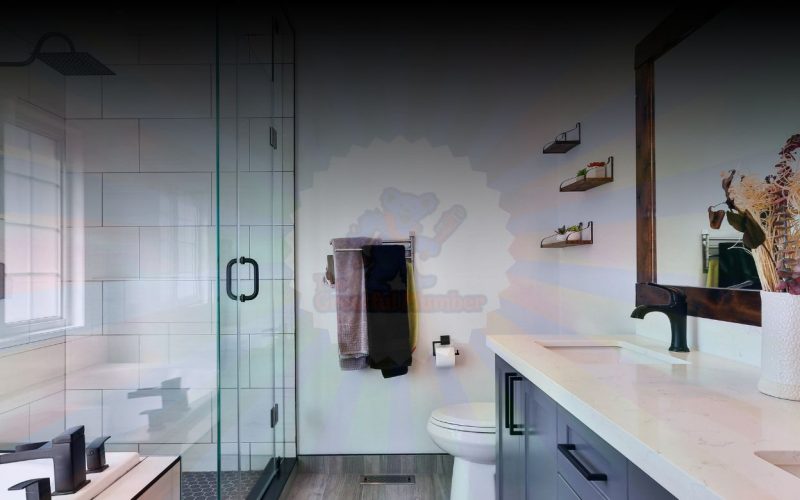You’ve been dreaming about updating that outdated bathroom, and you’re thinking “How much could a small bathroom really cost?” The honest answer: it depends on a lot more factors than you probably realize—and many of those factors you won’t discover until the walls come down.
Let’s talk about what bathroom renovations actually cost in Jacksonville, what surprises await behind those walls, and why that “simple” update often becomes something much bigger.
The Three Basic Small Bathroom Configurations
Generally speaking, there are really only three configurations for a small bathroom. Just because it’s a small bathroom doesn’t mean the cost is automatically small.
The Standard Setup:
- Vanity with sink
- Toilet
- Shower or shower-tub combo
That’s it. Sounds simple, right? The complexity—and cost—comes from everything else you can’t see.
What Actually Determines Your Costs
The cost really depends on what you as the homeowner want: the quality of materials used from tile to grout to vanity to fixtures to the toilet type to the shower to the bathtub.
Your Choice Factors:
- Do you want a shower-bath combo or separate units?
- Will it be glass doors, sliding doors, or just open with a curtain rod?
- What level are you aiming for—essentials, preferred, or premium?
- Are you DIYing most of it, some of it, or handling just the plumbing while contractors do walls, tiling, grout, flooring, and ceiling work?
It depends on the homeowner’s taste, requirements, and the square footage of the bathroom—where the walls are, ceiling height, all of that.
The DIY Reality Check
If you’re going to do it yourself, it’s a lot of work. It’s a big project—bigger than most people think.
You buy the materials and supplies, you’re talking a couple thousand dollars if you have the tools. Another couple thousand if you need to buy tools.
But here’s what most people don’t consider: are we replacing existing fixtures, or are we putting in completely new ones? What’s the condition of the room currently? Are we going to have to do tile work, or are we going to just take a vanity out and simply put a new one in?
If we have to install a brand new valve system in the wall, if we have to cut open walls, you’re going to have to handle drywall repair because we don’t do the drywall. Is there trim? Is there molding? Is tile involved?
The Surprises That Change Everything
The most common surprises are unknown materials popping up behind the wall. Does the shower valve need to be replaced? Does the toilet flange need to be replaced? Is all the piping behind the walls in good shape? Are there venting issues causing problems for the bathroom or other parts of the house?
Typical Surprises:
- Old pipes and old materials
- Small leaks that nobody noticed
- Mold requiring restoration company involvement
- Venting issues affecting other parts of the house
- Unknown problems that arise from opening up walls
These are typically surprising to us, so you can imagine they’d be surprising to the homeowner—especially in cases where everything seemed to work fine. You just never really know what’s behind the wall until you open it up.
If the walls are already opened up, you might as well address these issues now because you don’t want to have to come back and open up the walls again.
Jacksonville’s Hidden Challenges
There are definitely neighborhoods and areas around Jacksonville that have old cast iron. Some areas have galvanized. Newer areas have PEX. Sometimes it’s in great condition, sometimes things are failing.
So many factors depend on things like landscape—roots from trees that have been cut down but the roots are still growing. Homeowners really just don’t know what’s in the ceilings and walls, especially in two-story homes. There seems to be a lot of surprises.
Neighborhood Patterns:
- Older downtown areas: Cast iron systems, more complications
- Mid-century neighborhoods: Galvanized pipes, mixed materials
- Newer developments: PEX systems, fewer surprises
- All areas: Root intrusion and environmental factors
When Small Projects Become Big Projects
Sometimes a small leak leads to an entire renovation because the existing tub-shower isn’t really something they like.
Real Example: The Expanding Scope
We got a call to remove an old tub and replace it with a standard shower-tub combo. It wound up becoming an entire bathroom remodel because we had to remove the old tub, fix a lot of the pipe, connect to the existing pipe, and the walls were already opened.
They didn’t like what they had, and as we started work, they decided to do an entire renovation. This happens more than you would think, especially in older homes.
Another Example: Hidden Water Damage
A customer noticed water leaking—the shower wasn’t draining properly. Turns out the old galvanized pipes underneath were broken and allowing water behind and through the wall, which led to mold.
The bathroom walls in good condition were certainly out of date by about 25 years. In order to fix it correctly, we were going to have to pull out a lot more things, and it became a much bigger, more expensive remodel than they really wanted to tackle at that time.
The Financial Reality
Sometimes it financially makes more sense to redo the entire bathroom, but sometimes it doesn’t. Sometimes customers can’t handle the full scope, and we understand that.
We want to give them the best solution we can provide within their budget. We do offer financing for people because sometimes things just spiral in a way nobody anticipated.
Cost Escalation Factors:
- Hidden damage requiring additional work
- Deciding to upgrade while walls are open
- Code compliance requirements for older homes
- Material choices expanding during the project
- Discovery of related problems in adjacent areas
Planning vs. Reality
I hate to keep saying “it depends,” but it really does depend on a whole lot of factors.
What We Know Going In
- Basic configuration and size
- Homeowner’s initial material preferences
- Visible condition of existing fixtures
What We Discover
- Condition of pipes behind walls
- Structural issues or water damage
- Code compliance requirements
- Compatibility with existing systems
- Additional work needed for proper installation
Making Smart Decisions
Before You Start
- Have a realistic budget that includes a 20-30% contingency
- Decide your must-haves vs. nice-to-haves
- Understand that opening walls often reveals additional needs
- Consider financing options for unexpected discoveries
During the Project
- Make upgrade decisions quickly to avoid delays
- Address discovered issues while access is available
- Communicate budget concerns immediately
- Remember that proper fixes prevent future problems
Key Questions to Ask
- What’s the condition of pipes we can’t see?
- Are there any code updates required?
- What happens if we find damage behind walls?
- Can we phase the work if budget becomes an issue?
The Bottom Line on Bathroom Renovation Costs
There’s no such thing as a “small” bathroom renovation cost when you factor in all the variables. The size of the bathroom is just one factor—and often not the biggest one.
Your costs will depend on:
- Your material and fixture choices
- The condition of hidden infrastructure
- How much work you’re doing yourself
- What surprises we find behind the walls
- Whether you decide to upgrade while we’re there
Getting Realistic Expectations
The best approach is to start with what you want to achieve, understand that discoveries are normal, and have a plan for handling the unexpected.
We’ll always give you honest information about what we find and what your options are. Sometimes that means scaling back, sometimes it means taking advantage of having everything open to do things right.
The most expensive bathroom renovation is one that has to be redone because problems weren’t addressed the first time.
Planning a bathroom renovation in Jacksonville? Call us at (904) 643-3946 for an honest assessment of your plumbing situation and realistic cost expectations. We’ll help you understand what you’re working with before you start tearing down walls.








